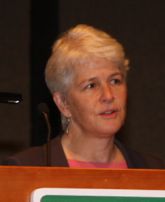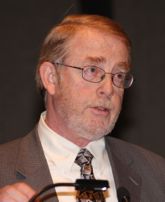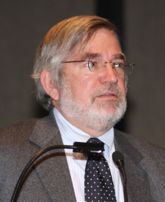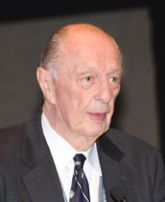CONGRESS ON ASSESSING AMERICA'S RENEWABLE ENERGY FUTURE
U.S. Geological Survey Center
Reston, Virginia
Sponsored by
U.S. FISH AND WILDLIFE SERVICE
U.S. DEPARTMENT OF AGRICULTURE
with support from
U.S. FOREST SERVICE
America presently faces serious consequences of its current, high-carbon energy portfolio. Unchecked climate change, pollution, and energy-security issues are some of the consequences. As America prepares for its energy future, a broader range of energy options -- including renewables -- will be evaluated. The energy choices made within the coming decades will have a critical impact on the environmental and economic future of America. It is imperative that natural resources professionals, scientists, engineers, policymakers and the commercial sector join together is assessing how renewable energy sources can best contribute to America’s energy portfolio.
A diverse mix of delegates attended the congress. Delegate diversity is a staple of RNRF's national meetings. Delegates learned about each renewable energy option, current scientific and operational impediments, and the most promising paths to commercial success. Congress objectives included:
- Discussing the state of renewable energy in America including current federal programs.
- Providing an overview of each renewable energy alternatives’ science and technology, environmental impacts, commercial barriers, and science needs.
- Presenting an interactive forum to discuss solutions for overcoming barriers including multi-party collaboration opportunities.
Ample time for delegate participation was provided following each presentation, and the second day included facilitated breakout session for more in-depth dialog. Delegate findings and recommendations will be featured in the report of the congress.
The report of the congress was provided to a variety of audiences including the U.S. Congress and its committees, federal agencies, state government (natural resource agencies and state legislatures), local and county governments, the scientific community (including RNRF’s member organizations), universities, industries based upon renewable natural resources, public interest and environmental advocacy groups, and the public.
SPEAKERS

Barry Starke
RNRF Chairman

Sarah Gerould
U.S. Geological Survey

Tom Darin
U.S. Department of Energy

Neil Rondorf
Science Applications
International Corporation

Ray Brady
Bureau of Land Management

James Lyons
Novus Energy Partners

Ken Zweibel
George Washington University

Scott Stephens
U.S. Department of Energy

Brennan Smith
Oak Ridge National Laboratory

Kamu Sadiki
U.S. Army Corps of Engineers

Linda Church Ciocci
National Hydropower Association

Roy Mink
U.S. Geothermal and Nevada Power

Brenda Pierce
U.S. Geological Survey

Karl Gawell
Geothermal Energy Association

Tom Richard
Pennsylvania State University

Bill Hagy
U.S. Department of Agriculture

Bill Holmberg
Council on Renewable Energy

Charyl Amrani
U.S. Fish and Wildlife Service
PROGRAM
DECEMBER 8, 2009
8:00 am - 8:30 am
Registration and Continental Breakfast
8:30 am - 8:40 am
Welcome and Opening Remarks
Barry W. Starke, RNRF Chairman
Former President, American Society of Landscape Architects
Principal, Earth Design Associates
USGS Welcome
Sarah Gerould, Senior Program Officer - Science Policy, Planning and Review, U.S. Geological Survey and
Chair, RNRF Congress Program Committee
8:40 am - 8:50 am
Congress Context and Goals
Robert D. Day, RNRF Executive Director
8:50 am - 9:30 am
The Federal Plan: Creating America's Renewable Energy Portfolio and Energy Distribution Overview
Tom Darin, Office of Electricity Delivery & Energy Reliability, U.S. Department of Energy
The speaker will provide an overview of the environmental, economic, and political factors that are forming the basis for renewable energy adoption in America (growing energy demand, climate change, job creation, pollution reduction, national security, etc.), and explain the administration's plan for creating a new renewable energy future. The speaker also will describe the condition and capacity of America’s electrical grid system, and the technical, financial and political actions that will be required to rehabilitate and upgrade the system to accommodate current and future needs, including a robust mix of renewable energy alternatives.
[PDF Presentation]
9:30 am - 10:00 am
Discussion and Questions
10:00 am - 10:20 am
Break
10:20 am - 11:20 am
Wind Energy Panel
Neil E. Rondorf, Vice President, Science Applications International Corporation
A general overview of wind energy’s science and technology issues (applications, current and potential energy capacity, energy flow issues and spatial issues, etc.), and an explanation of the most pressing environmental impacts
[PDF Presentation]
Ray Brady, Manager, Energy Policy Team, Bureau of Land Management
Federal agency wind energy missions, programs, and administrative and financial challenges, and insights and/or recommendations regarding multi-party participation
[PDF Presentation]
James P. Lyons, Chief Technology Officer, Novus Energy Partners; and former GE Global Research Chief Engineer, Electronics & Energy Conversion
How wind energy sources can reach their potential, and the greatest barriers (economic, technical, political) that constrain wind energy from meeting its safest and most effective potential
[PDF Presentation]
11:20 am - 11:45 am
Discussion and Questions
11:55 am - 12:55 pm
Lunch
12:55 pm - 1:55 pm
Solar Energy Panel
Ken Zweibel, Director, GW Solar Institute, George Washington University
A general overview of solar energy’s science and technology issues (applications, current and potential energy capacity, energy flow issues and spatial issues, etc.), and an explanation of the most pressing environmental impacts
[PDF Presentation]
Scott Stephens, Technology Manager, Solar Energy Technologies Program, U.S. Department of Energy
Federal agency solar energy missions, programs, and administrative and financial challenges, and insights and/or recommendations regarding multi-party participation
[PDF Presentation]
Kent Bakke, Continuum Energy Solutions
How solar energy sources can reach their potential, and the greatest barriers (economic, technical, political) that constrain solar energy from meeting its safest and most effective potential
1:55 pm - 2:20 pm
Discussion and Questions
2:20 pm - 3:20 pm
Hydroelectric Energy Panel
Brennan T. Smith, Program Manager, Wind and Water Power Technologies, EERE Program, Oak Ridge National Laboratory
A general overview of hydroelectric’s science and technology issues (applications, current and potential energy capacity, energy flow issues and spatial issues, etc.), and an explanation of the most pressing environmental impacts
[PDF Presentation]
Kamau Sadiki, National Hydropower Business Line Manager, Headquarters, U.S. Army Corps of Engineers
Federal agency hydroelectric missions, programs, and administrative and financial challenges, and insights and/or recommendations regarding multi-party participation
[PDF Presentation]
Linda Church Ciocci, Executive Director, National Hydropower Association
How hydroelectric sources can reach their potential, and the greatest barriers (economic, technical, political) that constrain hydroelectric energy from meeting its safest and most effective potential
[PDF Presentation]
3:20 pm - 3:45 pm
Discussion and Questions
3:45 pm - 4:00 pm
Break
4:00 pm - 5:00 pm
Geothermal Energy Panel
Roy Mink, Board Member, U.S. Geothermal and Nevada Power; consultant, water and geothermal energy
A general overview of geothermal energy’s science and technology issues (applications, current and potential energy capacity, energy flow issues and spatial issues, etc.), and an explanation of the most pressing environmental impacts
[PDF Presentation]
Brenda S. Pierce, Program Coordinator, Energy Resources Program, U.S. Geological Survey
Federal agency geothermal energy missions, programs, and administrative and financial challenges, and insights and/or recommendations regarding multi-party participation
[PDF Presentation]
Karl Gawell, Executive Director, Geothermal Energy Association
How geothermal energy sources can reach their potential, and the greatest barriers (economic, technical, political) that constrain geothermal energy from meeting its safest and most effective potential
[PDF Presentation]
5:00 pm - 5:25 pm
Discussion and Questions
5:25 pm - 5:30 pm
Concluding remarks
DECEMBER 9, 2009
8:30 am - 9:00 am
Continental Breakfast
9:00 am - 9:05 am
Welcome / Overview of Agenda
Barry Starke
9:05 am - 10:05 am
Biomass Energy Panel
Tom Richard, Professor, Agricultural and Biological Engineering, Director, Biomass Energy Center, Pennsylvania State University
A general overview of biomass energy’s science and technology issues (applications, current and potential energy capacity, energy flow issues and spatial issues, etc.), and an explanation of the most pressing environmental impacts
[PDF Presentation]
Bill Hagy, Special Assistant and Director of Alternative Energy Policy, USDA Rural Development
Federal agency biomass energy missions, programs, and administrative and financial challenges, and insights and/or recommendations regarding multi-party participation
[PDF Presentation] [National Biofuels Action Plan - October 2008]
Bill Holmberg, Chairman, Biomass Coordinating Council, American Council on Renewable Energy
How biomass energy sources can reach their potential, and the greatest barriers (economic, technical, political) that constrain biomass energy from meeting its safest and most effective potential
[PDF Presentation]
10:05 am - 10:30 am
Discussion and Questions
10:30 am - 10:45 am
Break
10:45 am - 11:45 am
Case Studies: Multi-party Dialogs
Speakers from two different multi-party efforts explain their interdisciplinary partnerships and programs, challenges they face, remaining obstacles, and advice for implementing new multi-party dialogs.
1) Wind Turbine Guidelines Advisory Committee
Cheryl R. Amrani, Fish and Wildlife Biologist, Division of Fisheries and Habitat Conservation, for
David J. Stout, Chief, Division of Habitat and Resource Conservation, Fisheries and Habitat Conservation, U.S. Fish and Wildlife Service
The committee provides advice and recommendations to the Secretary of the Interior on developing effective measures to avoid or minimize impacts to wildlife and their habitats related to land-based wind-energy facilities. Committee members represent the varied interests associated with wind energy development and wildlife management.
[PDF Presentation]
2) The Biomass Research and Development Board
Bill Hagy, Special Assistant and Director of Alternative Energy Policy, USDA Rural Development
The board was created by the Biomass Research and Development Act of 2000, which was further amended by the Food, Conservation and Energy Act of 2008. The board's mission is to coordinate federal research and development activities relating to bio-based fuels, power, and products.
[PDF Presentation]
11:45 am - 12:15 pm
Discussion and Questions
12:15 pm - 12:25 pm
Explanation of Working Group Procedures
12:25 pm - 1:25 pm
Lunch
1:25 pm - 1:55 pm
Breakout Session I / Scientific, Technical, and Environmental Needs
2:00 pm - 2:30 pm
Breakout Session II / Developing Multi-party Partnerships
2:30 pm - 2:45 pm
Break
2:45 pm - 3:15 pm
Breakout Session III / Assessing National Policies and Programs
3:20 pm - 4:00 pm
Working Group Synopses and Discussion
4:00 pm - 4:10 pm
Concluding Remarks
Robert D. Day, RNRF Executive Director
CONGRESS PROGRAM COMMITTEE
Chair:
Sarah Gerould, RNRF Board Member; Former Board Member, Society of Environmental Toxicology and Chemistry; Senior Program Officer, Science Policy, Planning and Review, Biological Resources Discipline, U.S. Geological Survey
Members:
Tom Chase, RNRF Board Member; Director, Coasts, Oceans, and Ports Institute, American Society of Civil Engineers
Robert Day, RNRF Executive Director
Richard Duesterhaus, RNRF Board Member; Former President, Soil and Water Conservation Society; Senior Advisor, National Association of Conservation Districts
Richard Engberg, RNRF Board Member; Technical Director, American Water Resources Association
Albert Grant, RNRF Board Member; Former President, American Society of Civil Engineers; Consulting Civil Engineer
Christopher Lant, RNRF Board Member; Executive Director, Universities Council on Water Resources; Professor of Geography, Southern Illinois University
Ronald D. McPherson, RNRF Board Member; Executive Director Emeritus, American Meteorological Society
Howard Rosen, RNRF Vice-Chairman; Former President, Society of Wood Science and Technology; volunteer, U.S. Forest Service
Nancy C. Somerville, RNRF Board Member; Executive Vice President, American Society of Landscape Architects
A. F. Spilhaus, Jr., Executive Director Emeritus, American Geophysical Union
Barry Starke, RNRF Chairman; Former President, American Society of Landscape Architects; Principal, Earth Design Associates
Staff Liaisons:
Ellen Vaughan, RNRF Program Director
